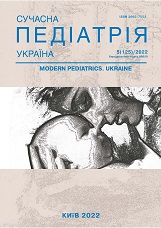Juvenile systemic sclerosis in children (clinical case)
DOI:
https://doi.org/10.15574/SP.2022.125.128Keywords:
child, immunological markers, intima-media complex, capillaroscopy, treatmentAbstract
The up-to-date data on origin, diagnostic approach and treatment of juvenile systemic scleroderma in the child with the disease onset at early age are presented in the article. The diagnostic value of anamnesis and clinical data, laboratory and instrumental methods of investigation, in particular, identification of juvenile systemic scleroderma immunological markers, ultrasound Doppler scan of vessels as well as capillaroscopy of the nail bed are covered.The main data of instrumental examinations for the diagnosis were pulmonary fibrosis, decreased cardiac ejection fraction of left ventricles, large-focal cardiosclerosis, thickening of the intima-media complex, signs of peripheral vascular Raynaud's phenomenon. The diagnostic laboratory markers are increased titers of antibodies to native and denatured DNA, antibodies to nucleosomes, antibodies to Scl-70, circulating immune complexes and CRP. The treatment regimen should be developed individually and be aimed at deceleration of the progression of the autoimmune process.The research was carried out in accordance with the principles of the Helsinki Declaration. The informed consent of the patient was obtained for conducting the studies.No conflict of interests was declared by the authors.
References
Culpo R, Vastert SJ, Ravelli A et al. (2014). SHARE - work package 5: evidence based recommendations for diagnosis and treatment of juvenile localized scleroderma and juvenile systemic sclerosis. Pediatr Rheumatol. 12: 117. https://doi.org/10.1186/1546-0096-12-S1-P117; PMCid:PMC4190868
Foeldvari I, Culpo R, Sperotto F, Anton J et al. (2021). Consensus-based recommendations for the management of juvenile systemic sclerosis. Rheumatology (Oxford). 60 (4): 1651-1658. https://doi.org/10.1136/annrheumdis-2018-214697; PMid:30826775 PMCid:PMC6691928
Kaldas M, Khanna PP, Furst DE, investigators of the human recombinant relaxin and oral bovine collagen clinical trials. (2009). Sensitivity to change of the modified Rodnan skin score in diffuse systemic sclerosis-assessment of individual body sites in two large randomized controlled trials. Rheumatology (Oxford, England). 48 (9): 1143-1146. https://doi.org/10.1093/rheumatology/kep202; PMid:19605370 PMCid:PMC2734267
Kowal-Bielecka O, Landewé R, Avouac J, Chwiesko S, Miniati I, Czirjak L et al. (2009). EULAR recommendations for the treatment of systemic sclerosis: a report from the EULAR Scleroderma Trials and Research group (EUSTAR). Ann Rheum Dis. 68 (5): 620-628. https://doi.org/10.1136/ard.2008.096677; PMid:19147617
Li SC. (2018). Scleroderma in children and adolescents: localized scleroderma and systemic sclerosis. Pediatr Clin North Am. 65: 757-781. https://doi.org/10.1016/j.pcl.2018.04.002; PMid:30031497
Marushko T, Kurilina T, Taranenko T, Marushko Yu. (2022). Features of the course of and diagnostics of juvenile localized scleroderma: analysis of clinical cases. Modern Pediatrics. Ukraine. 4(124): 28-33. https://doi.org/10.15574/SP.2022.124.28
Omelchenko LI, Mukvich OM, Ismakaeva DL, Belskaya OA, Ludvik TA. (2021). Concentration of 25(OH)D in blood serum and certain aspects of the clinical course of juvenile scleroderma. Ukrainian Journal of Perinatology and Pediatrics. 3(87): 44-50. https://doi.org/10.15574/PP.2021.87.44
Petty RE. (2021). Textbook of Pediatric Rheumatology. Elsevier. 8: 768.
Stevens AM, Torok KS, Li SC, Taber SF, Lu TT, Zulian F. (2019). Immunopathogenesis of Juvenile Systemic Sclerosis. Frontiers in immunology. 10: 1352. https://doi.org/10.3389/fimmu.2019.01352; PMid:31293569 PMCid:PMC6603145
Stevens BE, Torok KS, Li SC, Childhood Arthritis and Rheumatology Research Alliance Registry Investigators. (2018). Clinical Characteristics and Factors Associated With Disability and Impaired Quality of Life in Children With Juvenile Systemic Sclerosis: Results From the Childhood Arthritis and Rheumatology Research Alliance Legacy Registry. Arthritis care & research. 70 (12): 1806-1813. https://doi.org/10.1002/acr.23547; PMid:29457372 PMCid:PMC6344352
Van den Hoogen F, Khanna D, Fransen J et al. (2013). 2013 classification criteria for systemic sclerosis: an American college of rheumatology / European league against rheumatism collaborative initiative. Ann Rheum Dis. 72 (11): 1747-1755. https://doi.org/10.1136/annrheumdis-2013-204424; PMid:24092682
Volkmann ER, Varga J. (2019). Emerging targets of disease-modifying therapy for systemic sclerosis. Nat Rev Rheumatol. 15: 208-224. https://doi.org/10.1038/s41584-019-0184-z; PMid:30796362
Downloads
Published
Issue
Section
License
Copyright (c) 2022 Modern pediatrics. Ukraine

This work is licensed under a Creative Commons Attribution-NonCommercial 4.0 International License.
The policy of the Journal “MODERN PEDIATRICS. UKRAINE” is compatible with the vast majority of funders' of open access and self-archiving policies. The journal provides immediate open access route being convinced that everyone – not only scientists - can benefit from research results, and publishes articles exclusively under open access distribution, with a Creative Commons Attribution-Noncommercial 4.0 international license (СС BY-NC).
Authors transfer the copyright to the Journal “MODERN PEDIATRICS. UKRAINE” when the manuscript is accepted for publication. Authors declare that this manuscript has not been published nor is under simultaneous consideration for publication elsewhere. After publication, the articles become freely available on-line to the public.
Readers have the right to use, distribute, and reproduce articles in any medium, provided the articles and the journal are properly cited.
The use of published materials for commercial purposes is strongly prohibited.

